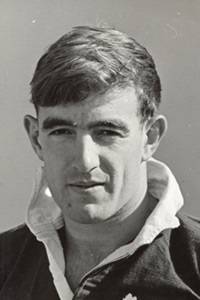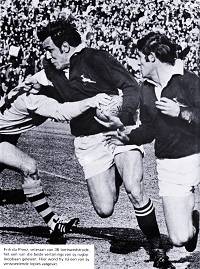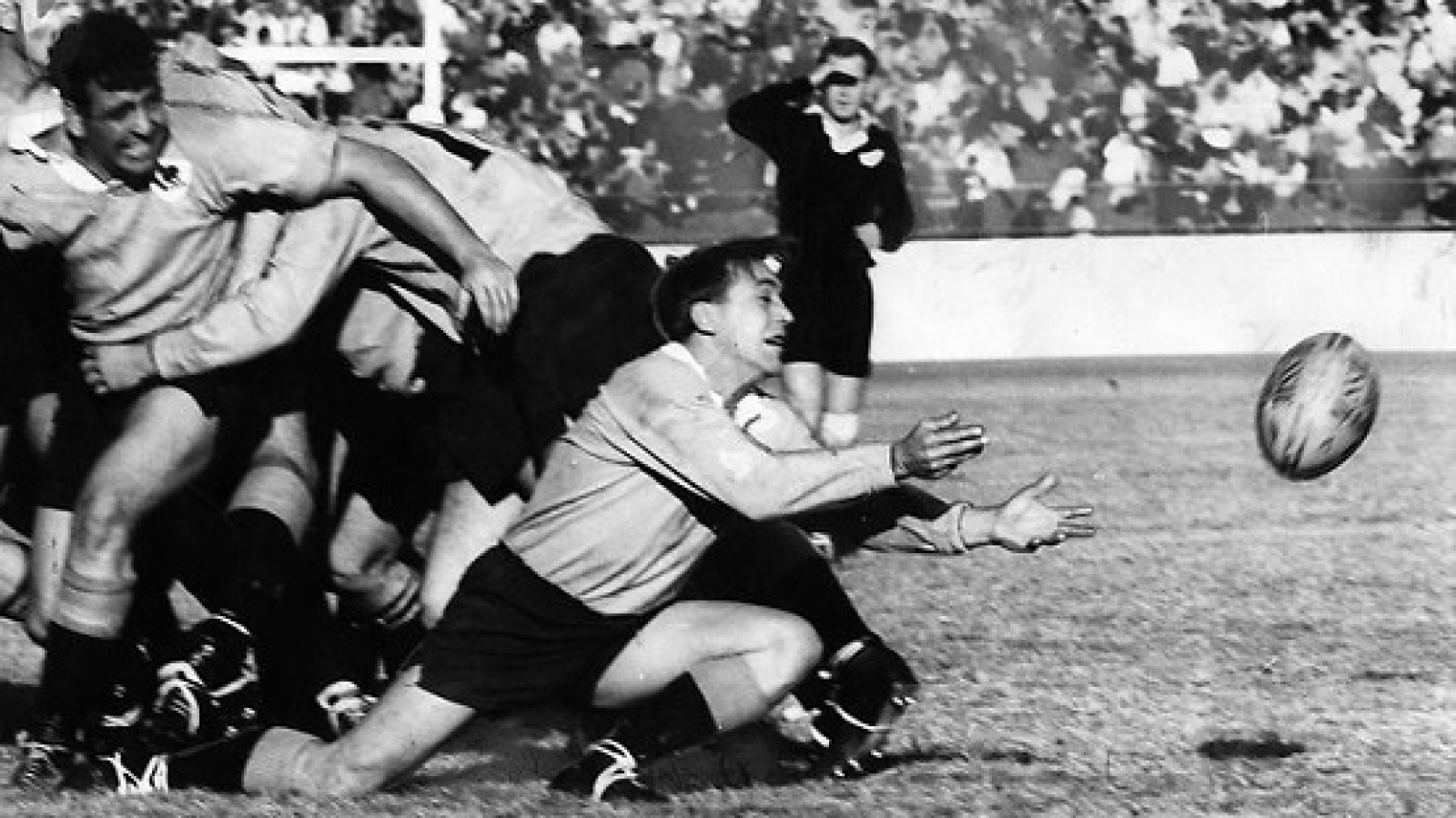Ken Catchpole
This article is the first in a series where we interview and ask some of the most famous names in Sydney Uni rugby history – who is the greatest XV of all time. We’ve asked players from different generations and have started with the 1970’s. Rupert Rosenblum played 3 tests from 1969 and is a stalwart of Sydney Uni. His love for the running game is legendary….. although Rupert was known more for his prodigious boot and disdain for any form of contact.
Before we start – there is an important caveat. Rupert (like a few of our celebrity selectors) has only picked from players from his era. “The rugby is so different – the forwards game has changed too much.” As you would expect, Rupert has made some left field selections. However, his team contains some extraordinary rugby players and both the All Black and Springbok “player of the 20th century”.
Fullback – Gary Smoker (Australia) is most underestimated player Rupert has seen and has no hesitation in picking him in the world XV. Gary was the Sydney Uni fullback who had “impeccable timing when joining the line and perfect positional play. Rupert picked him ahead of more fancied names like JPR Williams because “the ball never seemed to bounce when the opposition kicked to us and Gary could kick long range field goals”.
 The Wings – Stewart and Jim Boyce (pictured on left), Australia. Stuart had a great side step and Jim was a straight and hard runner. Indeed, the twins were Australia’s outstanding wingers during the Thornett era when the Wallabies scored famous away victories over the Springboks and the All Blacks. They were noted for their reliability in attack and defence and the pinpoint accuracy of their throws to the lineout. In 1965 the Australian Rugby Almanac named Stewart as one of the five best players of the year.
The Wings – Stewart and Jim Boyce (pictured on left), Australia. Stuart had a great side step and Jim was a straight and hard runner. Indeed, the twins were Australia’s outstanding wingers during the Thornett era when the Wallabies scored famous away victories over the Springboks and the All Blacks. They were noted for their reliability in attack and defence and the pinpoint accuracy of their throws to the lineout. In 1965 the Australian Rugby Almanac named Stewart as one of the five best players of the year.
No. 13 – Phil Smith (Australia) was an exceptional athlete – as big and fast as the modern day players and extremely competitive. He played a number of tests before switching to rugby league in 1970 signing a four year contract with South Sydney. Smith passed away in 2000 at the age of 53 – his obituary acknowledges his subtlety on the field as well as his extraordinary athletic career.
No. 12 – Jo Maso (France) played with the typically adventurous French spirit – “when he ran no-one knew which way is he going to go”. After switching from rugby league he went on to play 25 tests and is currently the manager of the French side.
Flyhalf – Richard Sharp (England) scored a sensational try at Twickenham in 1963 from a set piece against Scotland. Cliff Morgan described it as “all grace, pace and coordination. For a flyhalf watching a flyhalf, this try was the ultimate”.
Halfback – Ken Catchpole (Australia) was miles in front of every other player and person. “Did you ever get a headache from trying to work out what another player was going to do? Ken was the only player I couldn’t keep up with”. The other names Rupert considered were players like Gareth Edwards, but, unlike other positions, Rupert would not be swayed. “There is only one possibility at halfback”.
No. 8 – Tommy Bedford (South Africa) played 25 tests for the Springboks (3 as Captain) and made his debut at 21. Rupert commented “Tommy made my life a misery. His speed was unbelievable and anticipation was faultless”. Despite Tommy’s prowess as a player and captain, it is thought that his relentless and uncompromising criticism of the apartheid system and the rugby establishment contributed to a premature end of his playing career.
Flanker – Jean Pierre Rives (France) was praised by the BBC for his “ultra-committed, guts-and-glory style of play.” He won 59 caps for France (34 as Captain). In typical French fashion Rives retired to concentrate on his art. He is now a painter and a sculptor.
Flanker – Kel Tremain (New Zealand) is a legend of New Zealand rugby having played for the All Blacks between 1959 and 1968. He was “big fast and totally uncompromising”. He died suddenly aged only 54 after a short illness. The Kelvin Tremain Memorial Trophy is awarded annually to New Zealand’s player of the year.

Lock – Colin “Pinetree” Meads is one of the best second rowers of all time. Rupert suggested that selecting Colin and Ken Catchpole may cause some tension (google it) but you can’t deny his ability. Meads played 55 test matches for the All Blacks, from 1957 until 1971. He was named new Zealand’s Player of the Century at the NZRFU Awards in 1999.
Lock – Frik du Preez (pictured left) was “sensational, simply sensational”. A big, fast and skillful lock who could kick goals and drop goals. Hailing from a farm near Rustenburg he represented the Springboks over a decade and was named South Africa’s rugby player of the 20th century
Tighthead Prop – Mof Myburgh was a man you didn’t mess with. He was a detective in the South African police force and a stalwart of the (now) Blue Bulls. Rupert described him as “immovable at 20+ stone. To get round him you had to take a detour”.
Loosehead Prop – Jim Roxburgh was a very light loosehead and “although he suffered against the biggest packs, he won a test match on his own against the French”. He was very mobile and played like another loose forward.
Peter Johnstone (New Zealand) was a Kiwi hooker “who had a loud mouth and was extremely insulting”. Fortunately he could back it up on the field and is the final selection in Rupert’s World XV.
In summary…
Fullback – Gary Smoker (Australia)
Right wing – Stewart Boyce (Australia)
Left wing – Jim Boyce (Australia)
Centre – Phil Smith (Australia)
2nd Five-eighths – Jo Maso (France)
1st Five-eighths – Richard Sharp (Wales)
Halfback – Ken Catchpole (Australia)
No.8 – Tommy Bedford (South Africa)
Flanker – Kel Tremain (New Zealand)
Flanker – Jean Pierre Rives (France)
Lock – Colin Meads (New Zealand)
Lock – Frik Du Preez (South Africa)
Tight-head prop – Mof Myburgh (South Africa)
Loose-head prop – Jim Roxburgh (Australia)
Hooker – Peter Johnson (New Zealand)
National representation: Australia (6), South Africa (3), New Zealand(3), France (2), England (1)

